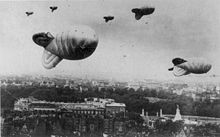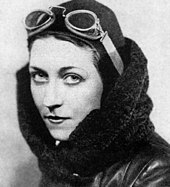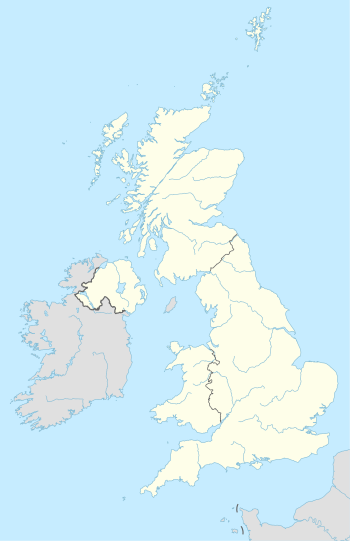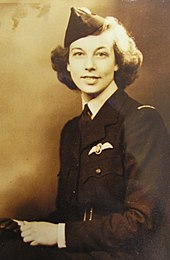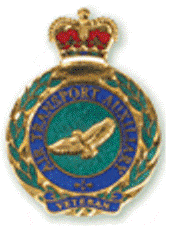Air Transport Auxiliary
The Air Transport Auxiliary (ATA) was a British civil air transport support organization operating during World War II , whose pilots transported new, damaged and repaired Royal Air Force aircraft between factories, assembly plants, maintenance units and scrap yards, as well as active service squadrons and airfields . They also flew service personnel from one place to another and took on air ambulance flights. From 1943 the ATA was the first British government organization to pay female pilots the same wages as their male colleagues.
Foundation of the ATA
As early as 1938, Gérard d'Erlanger (1906–1962), banker and director of the airline BOAC , foresaw that civil aviation in Great Britain would be severely restricted in a war with Germany . Some civilian pilots would be accepted by the Royal Air Force (RAF), but many experienced pilots would not be fit for military service. At the same time, he expected in this case a high demand for pilots who could carry out transport flights for material and mail as well as medical personnel, injured persons and VIPs . In August 1939, d'Erlanger contacted Baron Harold Balfour (1897–1988), Secretary of State for Aviation, and Sir Francis Shelmerdine (1882–1945), Director General for Civil Aviation, and suggested that they establish an association of civilian pilots, who would be willing to take on this task.
D'Erlanger's proposal was accepted and the organization, with the working title “Air Transport Auxiliary”, was set up at Whitchurch Airfield in Bristol , where a British Airways military base was located. ATA was under the direction of National Air Communications and the Director General of Civil Aviation, while British Airways was responsible for office, staff and administrative purposes. D'Erlanger was promoted to the rank of Commodore as head of the organization and was given the task of recruiting the pilots.
In February 1940, ATA headquarters were relocated to White Waltham Airfield near Maidenhead in Berkshire . From 1940 to 1941 the ATA was gradually subordinated to the Ministry of Aircraft Production (MAP) of Lord Beaverbrook . The management of the organization remained with Gérard d'Erlanger.
The official motto of the ATA was Aetheris Avidi ( Eager for the Air , "Eager for the air"). It is still operated today by the West London Aero Club , which is based at White Waltham Airfield. Unofficially it was called Anything to Anywhere .
Development phase
Recruitment of the pilots
As a prerequisite for ATA pilots, d'Erlanger defined possession of the private pilot license and at least 250 flight hours. He wrote to 1000 pilots and invited them to Whitchurch near Bristol for interviews and tests . Around 100 of them responded to the offer, 30 of which were initially selected, including an innkeeper, a motorcycle racer and an animal lover who had just flown his new pets - a cheetah and a chimpanzee - from Africa to Great Britain.
The ATA pilots jokingly interpreted the abbreviation of their organization as “Ancient and Tattered Airmen”, referring to their age and state of health. In order to qualify for membership in the ATA one had to be unfit for the RAF, but be able to fly an airplane.
As a result, many World War I veterans became ATA pilots, even if they were too old to serve in the RAF or had lost a limb or eye in the war. One of them was Stewart Keith-Jopp, uncle of ATA pilot Betty Keith-Jopp, who had been missing an arm and an eye since the First World War.
The first female pilots
Due to reservations in the Aviation Ministry, women were not originally included in the ATA. It was not until November 1939, after the beginning of the war, when pilots were becoming increasingly scarce and the ATA's orders more and more numerous, that it was decided to include women in the ATA. An important contribution to this was made by Pauline Gower , an experienced professional pilot with more than 2000 flying hours who, as a civil protection officer at the Civil Air Guard, was strongly committed to training women to become pilots.
The first eight female ATA pilots were hired on January 1, 1940. The so-called “First Eight” were Winifred Crossley († 2008), Margaret Cunnison (1914–2004), Margaret Fairweather (1901–1944, daughter of Lord Runciman ), Mona Friedlander (* 1915, national ice hockey player), Joan Hughes ( 1918–1993, the youngest at age 21), Gabrielle Patterson (1905–1968), Rosemary Rees (1901–1994), and Marion Wilberforce (1902–1995). They were all experienced pilots, each with over 600 flying hours, and certified flight instructors. 29-year-old Pauline Gower has been appointed head of the ATA women's section. She jokingly interpreted the abbreviation ATA for her team as “Always Terrified Airwomen” (in German roughly: “Always terrified fliers”).
Pilots from all over the world
Men and women came from all over the world to join the ATA. In the end, 25 nations were represented, including Canada, Australia, New Zealand, South Africa and the USA. There were also pilots from Chile, China, Russia and India. Even Prince Chirasakti (1918–1942), royal prince of Siam, flew for the ATA; he was killed in a crash on September 12, 1942. The largest contingent from Europe were 17 Poles, including three women, who reached Great Britain after fleeing via the Balkans and France. Flight captain Klemens Dlugaszewski had years of experience with the Polish airline LOT and had such an unpronounceable name that he was known as “Captain Double Whiskey”.
More staff
In addition to the total of 1,318 pilots, ATA employed a wide range of other staff. The 151 flight engineers were necessary for the flights of the four-engine machines, in addition, according to ATA statistics, 19 radio operators as well as 27 sea cadets and members of the Air Training Corps belonged to the flying personnel. Flight instructors and instructors took care of the training of the pilots. In addition, the ground crew included engineers, rescue teams, meteorologists, drivers, nurses and doctors as well as administrative employees. At the peak of the ATA in August 1944, the ground crew consisted of 2,786 employees, including 1,227 engineers.
Work of the ATA
tasks
It was originally intended that the pilots would fly light aircraft to carry mail, consignments of goods and medical supplies. But within a few weeks, the ATA began assisting the RAF in moving planes from factories and warehouses to the front squadrons. From February 1940, the ATA took over the entire transfer and thus relieved the pilots of the Royal Air Force and Royal Navy.
From May 1940, the ATA expanded rapidly, as a large number of Allied aircraft had to be transferred to operational areas on the continent due to the western campaign of the German Wehrmacht.
During the war, 1152 pilots and 166 female pilots from 25 countries carried out a total of around 309,000 transfer flights of 147 different types of aircraft, without radio equipment, without instrument flight instruction and exposed to British weather. Often times they were given a type of aircraft that they had never seen before.
The women were initially stationed in Hatfield (Hertfordshire) , north of London , and were only allowed to transfer Tiger Moth training aircraft from the nearby de Havilland factory to training airfields and storage units. Most of these destinations were in northern England and Scotland and the open cockpit aircraft had to be transferred in the middle of winter. Despite the harsh winter, the women did their job so well that as a result, a total of 166 female pilots were deployed in the ATA.
In July 1941 the Royal Air Force launched a major aerial offensive. Therefore, the capacity of the male ATA pilots was nowhere near enough and women were allowed to fly fighter planes as well. Four female pilots from the First Eight flew a Hawker Hurricane for the first time on July 19, 1941 , and in the autumn Lettice Curtis (1915-2014) became the first woman to fly a four-engine Avro Lancaster bomber . It was not until 1945 that female pilots transferred the first aircraft to mainland Europe.

The high number of transfer flights required detailed operational planning. To this end was in Andover (Hampshire) , the central operational control ( Central Ferry Control ) of the ATA. Overnight she distributed the work for the following day to the various pilot pools. There the operations managers had the task of assigning the upcoming transfer flights to the available aircraft crews according to their qualifications for the various aircraft types. One day's work for a pilot could involve several flights with different types of aircraft.
Passenger planes such as the Avro Anson and the Fairchild Argus were used as airplane taxis. They took the pilots to their first site and, if possible, picked them up again at the end of the day. When that was not possible, the pilots stayed in hotels near airfields or took an overnight train back to their base. An American pilot's journal, kept at the Maidenhead Heritage Center, shows he was fed up with British trains, as well as sitting around waiting for the British weather to improve, especially in winter.
A total of 17,059 flight hours for taxi flights were performed by the ATA, 8,489 hours of which abroad and 8,570 hours in Germany.
Training for different aircraft classes
The ATA pilots were generalists and able to fly a wide variety of aircraft. That differentiated them from the fighter pilots, who were specialized and intensively trained in certain types of aircraft and who mastered them with great virtuosity. At ATA, it was common for pilots to familiarize themselves with an unfamiliar aircraft within 20 minutes of take-off using a small ring binder, the so-called Ferry Pilot's Notes . The notebook contained the most important information about the controls and their settings during take-off and landing as well as during the flight phase.
As the number of orders increased and more and more new and less experienced pilots flew for the ATA, a systematic training program was set up to train the pilots for different classes of aircraft:
- Class 1: Single-engine light aircraft, especially trainer aircraft such as the Tiger Moth
- Class 2: Single-engine combat aircraft such as the Supermarine Spitfire , Hawker Hurricane , Vought F4U Corsair, and P-51 Mustang
- Class 2+: More difficult to control single-engine combat aircraft such as the Curtiss P-40 , Hawker Tempest , Hawker Typhoon and P-39 Airacobra variants
- Class 3: Twin-engine light aircraft
- Class 4: Twin-engine combat aircraft, including most of the medium bombers
- Class 4+: More difficult to control twin-engine warplanes, including Lockheed Hudson , Mosquito and older types and those with nose wheel landing gear , such as B. A-20 Havoc , P-38 Lightning , Martin B-26 Marauder, and B-25 Mitchell
- Class 5: Four-engined fighter aircraft including Lancaster , Stirling , Boeing B-17 Flying Fortress and B-24 Liberator
- Class 6: Flying boats such as PBY Catalina and Sunderland
The ATA had two flight schools. The initial training (“IFTS”, Initial Flight Training School ) took place at the Thame site, the advanced training (“AFTS”, Advanced Flight Training School ) took place in White Waltham. The two schools operated an average of 78 training aircraft that completed a total of 133,247 flight hours.
The training consisted of theoretical training and flying lessons on a representative aircraft of the respective class, first together with the flight instructor, then alone. It was then expected that the pilots would be able to transfer all types of aircraft in this class. If necessary, the details were taken from the Ferry Pilot's Notes before take-off . A pilot who was trained for class 5 therefore had to be able to fly any of the 147 aircraft types in service with the RAF without any special preparation.
Margot Duhalde, for example, the only Chilean female pilot in the ATA, was trained for classes 1, 2, 3, 4 and 4+ and delivered more than 1,000 aircraft between 1941 and 1945. In her autobiography, she listed over 50 types of aircraft that she transferred, including 15 versions of the Supermarine Spitfire alone .
Risks and Incidents
The ATA pilots were often exposed to serious risks during the transfer flights. They were not trained in instrument flight , so bad weather was a constant threat. Although the criteria for flight restrictions in bad weather were described in detail, the changeable English weather made it difficult to make a decision. Sometimes a few degrees drop in temperature could turn the clear sky into a cloudy nightmare. The ATA pilots also flew without a radio and their navigation equipment mostly consisted of a compass and a course gyro .
Barrier balloons and anti-aircraft battery fire from their own troops were also a threat. Because the pilots were not allowed to draw the position of the defense positions on their maps so that they could not fall into the hands of the enemy.
In the early years of the war, the RAF did not have complete air superiority over England, so attacks by German aircraft were a constant threat. In the event of an attack, the ATA pilots could not defend themselves. The planes they carried were mostly unarmed. If they had guns or cannons, they were still unloaded. This was done to protect the pilots so that they were not considered direct combatants under Article 3 of the Geneva Conventions .
The information on how many ATA crew members perished during the war is inconclusive. They vary between 149 (129 men and 20 women) and 170 pilots. In 1950 a memorial was erected for them in St Paul's Cathedral in London . The largest group of ATA graves is in the All Saints Cemetery in Maidenhead with 17 war graves for men and women from 6 different nations.
Among the fatalities is Amy Johnson , the most famous British female pilot, who in 1930 became the first woman to fly solo from England to Australia. On January 5, 1941, she was to transfer a twin-engine Airspeed Oxford Mk. II from Prestwick to Kidlington near Oxford alone , but never arrived there. The reconstruction of her flight revealed that she was probably irritated by blocking balloons in the Thames estuary, lost her orientation and fell into the sea. Amy Johnson's remains have never been found.
Pay equality
According to a standard provision by the UK Treasury, female ATA pilots received 20 percent less wages than their male counterparts until 1943, even though they performed the same duties and worked the same hours. The women even often worked under poorer conditions, because while the male pilots transferred modern combat aircraft with closed cockpits, the female pilots also had to fly machines like the Tiger Moth in winter , in which they were only protected by a small Plexiglas pane in the open cockpit were. Therefore, Irene Ward, Baroness Ward of North Tyneside , a Conservative MP in the British House of Commons and chair of the Commonwealth Women Parliamentarians (CWP) Association since 1941, campaigned for their equality.
On May 18, 1943, Irene Ward rose in the House of Commons to put a question to Sir Stafford Cripps , Minister for Aircraft Production. She asked him if he understood that the ATA pilots should receive the same pay as their male colleagues. Sir Stafford replied that from the following month these women should in fact receive the same pay as men of the same rank doing the same job.
This made the ATA probably the first major British organization or corporation where women and men received equal pay for the same work. At the same time, women who flew for the American Women Airforce Service Pilots (WASP) received only 65 percent of the wages their male colleagues received.
organization
Locations
Air Transport Auxiliary locations (1942) |
The ATA stationed their pilots in pools (ferry pools) , which were mostly located at airports near aircraft factories or Royal Air Force locations. Both male and female pilots worked in most of these pools. A few like Hamble, Cosford and Hatfield were only manned by female pilots.
In 1942 the ATA had the following pools, which were controlled from the operations center in Andover:
- No. 1 White Waltham
- No. 2 Whitchurch, Bristol
- No. 3 Hawarden near Chester
- No. 4 Prestwick, Scotland
- No. 5 Luton, later Thame
- No. 6 Ratcliffe, Leicester
- No. 7 Sherburn-in-Elmet, Leeds
- No. 8 Sydenham, Belfast
- No. 9 Aston Down at Stroud
- No. 10 Lossiemouth , Scotland
- No. 12 Cosford near Wolverhampton
- No. 14 Ringway , Manchester
- No. 15 Hamble, Southampton
- No. 16 Kirkbride, Cumbria
The numbers are not consecutive because some pools have been given up or moved to another location, for example if the production locations of the aircraft have changed.
Uniform and ranks
The Air Transport Auxiliary pilot's uniform was dark blue and consisted of trousers, a light blue RAF shirt, black tie and jacket with the ATA coat of arms and a field cap. Gold stripes on the shoulders indicated the rank.
When the ATA was founded, only two ranks were distinguished: A second officer was only allowed to fly single-engine machines, while a first officer was also approved for twin-engine machines. As a prerequisite, the latter required at least 500 hours of flight experience. The other ranks were introduced later, Gérard d'Erlanger was in the rank of Commodore .
Dissolution of the ATA after the Second World War
Further way of the pilots
After the end of World War II, the services of the ATA were practically no longer needed. Therefore the pilot pools were abandoned, only White Waltham and Whitchurch remained for a while. The pilots were bid farewell by Gérard d'Erlanger and received a certificate of service.
For most female pilots, this ended the days of professional aviation. There were enough male pilots again, and with it the chances of women in this profession decreased. Only a few women remained pilots.
Mary Ellis was seconded to the Royal Air Force and continued to transfer planes. She was one of the first women to fly the Gloster Meteor , Britain's first jet fighter aircraft. In 1950 she became the manager of Sandown Airfield on the Isle of Wight and hired her ATA colleague Vera Strodl as a flight instructor.
Diana Barnato Walker was the first female pilot to break the sound barrier in a jet aircraft in 1963, and Monique Agazarian founded her own charter airline.
Margot Duhalde (1920–2018) moved to the French Air Force for a few years and then returned to Chile as a civilian pilot, where she worked as an air traffic controller until old age and continued to pilot airplanes privately.
Diana Barnato Walker in the cockpit of an Airspeed Oxford (1944)
honors and awards
A special ATA air show was held in White Waltham on September 29, 1945 to raise money for the ATA Charity Fund to support the families of 170 ATA pilots who died while on duty. The aircraft manufacturers whose machines had been flown by the ATA also took part in the campaign. Allied and German aircraft were on display at the event, including a V1 , aircraft engines and even an anti-aircraft gun with a searchlight. The participating pilots also included the British test pilot Alex Henshaw (1912-2007) in a Supermarine Seafire .
During the closing ceremony for the dissolution of the ATA on November 30, 1945 in White Waltham, Lord Beaverbrook, Minister for Aircraft Production, paid tribute to the organization's achievements:
“Without the ATA, the days and nights of the Battle of Britain would have been conducted under conditions quite different from the actual events. They carried out the delivery of aircraft from the factories to the RAF, thus relieving countless numbers of RAF pilots for duty in the battle. Just as the Battle of Britain is the accomplishment and achievement of the RAF, likewise it can be declared that the ATA sustained and supported them in the battle. They were soldiers fighting in the struggle just as completely as if they had been engaged on the battlefront. "
“Without the ATA, the days and nights of the Battle of Britain would have been very different from what actually happened. You have carried out the delivery of aircraft from the factories to the RAF and thus relieved countless RAF pilots for use in the battle. Just as the Battle of Britain is the achievement and success of the RAF, it can also be said that the ATA supported and promoted them in the battle. They were soldiers who were just as engaged in combat as if they had been deployed on the war front. "
At the end of their service life, 36 ATA pilots, including two women, received a Certificate of Appreciation from the British Government. A total of 22 people received the Order of the British Empire for their services during their time at ATA , including Gérard d'Erlanger as Commander (CBE) and pilots Pauline Gower, Margot Gore, Joan Hughes and Rosemary Rees as Members (MBE).
After that, the ATA fell into oblivion for a long time before the British Prime Minister Gordon Brown honored the surviving members of the ATA at an event in 2008 and awarded them a veteran plaque.
literature
ATA pilots autobiographies
- Diana Barnato Walker: Spreading My Wings . Patrick Stephens, 1994, ISBN 1-85260-473-5 (English).
- Lettice Curtis: Lettice Curtis. Her Autobiography . Red Kite, Walton on Thames 2004 (English).
- Lettice Curtis: The Forgotten Pilots. A Story of the Air Transport Auxiliary 1939–45 . Nelson & Saunders, Olney, Bucks 1985, ISBN 0-947750-02-9 (English).
- Mary De Bunsen: Mount Up with Wings . Hutchinson, 1960 (English).
- Rosemary Du Cros: ATA Girl. Memoirs of a Wartime Ferry Pilot . Muller, London 1983 (English).
- Margot Duhalde: Margot Duhalde . Mujer Alada. 2006 (Spanish, archive.org [PDF]). Autobiography: “Margot Duhalde. The winged woman "
- Mary Ellis: A Spitfire Girl . Frontline Books, Barnsley 2016 (English).
- Nancy Miller Livingston Stratford: Contact! Britain! Createspace, 2011 (English).
- Dolores Theresa Moggridge: Woman Pilot . Michael Joseph, London 1957 (English). Reissue: Jackie Moggridge: Spitfire Girl. My Life in the Sky . Head of Zeus, London 2014 (English).
- Veronica Volkersz: The Sky and I . WH Allen, London 1956 (English).
- Ann Courtenay Edmonds Welch: Happy to Fly. To Autobiography . John Murray, London 1983 (English).
Individual biographies
- Michael Fahie: A Harvest of Memories. The Life of Pauline Gower MBE GMS Enterprises, Peterborough 1995 (English).
- Warren Hathaway: Pursuit of a Dream. The Story of Pilot Vera (Strodl) Dowling . PageMaster Publishing, Edmonton, Canada 2012 (English).
- Regina Trice Hawkins: Hazel Jane Raines, Pioneer Lady of Flight . Mercer University Press, Macon, GA 1996 (English).
- Nick Thomas: Naomi the Aviatrix . Createspace, 2011 (English).
Other non-fiction books
- Air Transport Auxiliary: Air Transport Auxiliary. (Handbook) . Reminder Book, White Waltham 1945.
- Hugh Bergel: Fly and Deliver. A Ferry Pilot's Log Book . Airlife Publishing, Shrewsbury 1982 (English).
- EC Cheesman: Letter Glory. The Story of ATA Harborough Publishing, Leicester 1946 (English).
- J. Gen Genovese: We Flew Without Guns . The John C. Winston Company, Philadelphia 1945 (English).
- Great Britain, Hugh Bergel: Flying Wartime Aircraft; ATA Ferry Pilots' Handling Notes for Seven World War II Aircraft . David & Charles, Newton Abbot 1972 (English).
- Jacky Hyams: The Female Few. Spitfire Heroines of the Air Transport Auxiliary . History Press, Gloucester 2012 (English).
- Alison King: Golden Wings . C. Arthur Pearson Ltd, London 1956 (English).
- YM Lucas: WAAF with Wings . GMS Enterprises, Peterborough 1992 (English).
- Arthur Henson Narracott: Unsung Heroes of the Air . F. Muller, London 1943 (English).
- Anthony Phelps: "I Couldn't Care Less." Harborough Pub. Co., Leicester 1945 (English).
- Helena Schrader: Sisters in Arms . Pen & Sword Aviation, Barnsley 2006 (English).
- Leonard Taylor: Airwomen's Work . Sir Isaac Pitman & Sons, London 1943 (English).
- Anthony Jack Walters: Air Transport Auxiliary (The Lost Child) . Aries Publications, Wallingford 2006 (English).
- Jo Wheeler: The Hurricane Girls. The Inspirational True Story of the Women who Dared to Fly . Penguin Books, London 2018, ISBN 978-0-241-35463-6 (English).
- Giles Whittell: Spitfire Women of World War II . HarperPress, 2007, ISBN 978-0-00-723535-3 (English).
Fiction
- Isla Dewar: Izzy's War . Ebury Press, 2010 (English).
- Carol Gould: Spitfire Girls. A Tale of the Lives and Loves Achievements and Heroism of the Women ATA Pilots in World War II . Black Ace Books, Forfar 1998 (English).
- Kate Lord Brown: The Beauty Chorus . Corvus Atlantic, London 2011 (English).
- Beryl Matthews: A Flight of Golden Wings . Severn House, Sutton 2007 (English).
- Margaret Morrison, Pamela Tulk-Hart: Paid to Be Safe . Hutchinson, London 1948 (English).
- Garry Ryan: Blackbirds . NeWest Press, Calgary, AB 2012 (English).
- Garry Ryan: Two Blackbirds . NeWest Press, Calgary, AB 2014 (English).
- Helena Schrader: The Lady in the Spitfire . iUniverse, Inc, Lincoln, Nebraska 2006 (English).
- EM Singer: Mother Flies Hurricanes . Avidia Cascade Press, Bend, OR 1999 (English).
- George Terrell: I'll Never Leave You . Writer's Showcase, San Jose 2001 (English).
- Elizabeth Wein: Code Name Verity . Electric Monkey, 2012 (English).
- Elizabeth Wein: Rose Under Fire . Electric Monkey, 2013 (English).
Documentaries
- Spitfire Sisters (2010) in the Internet Movie Database (English)
- Air Transport Auxiliary (2011) in the Internet Movie Database (English)
See also
- Women Airforce Service Pilots
- Amy Johnson
- Margot Duhalde
- Elsie Joy Davison
- James Allan Mollison
- Diana Barnato Walker
- Jacqueline Cochran
Web links
- British Air Transport Auxiliary. Accessed March 7, 2020 (English).
- Air Transport Auxiliary Association (ATAA). Accessed March 7, 2020 (English).
- Air Transport Auxiliary. In: Museum & Archive at Maidenhead Heritage Center. Retrieved March 1, 2020 .
- Air Transport Auxiliary. In: Royal Air Force Museum. Accessed March 7, 2020 (English).
- The Air Transport Auxiliary (ATA). In: British Airways. Accessed March 7, 2020 (English).
- Spitfire Sisters on YouTube , accessed March 11, 2020.
Individual evidence
- ↑ a b c d e f g h i j k l m n E.M. Singer: A Brief History of the Air Transport Auxiliary. Retrieved March 1, 2020 .
- ^ West London Aero Club. Retrieved March 9, 2020 .
- ↑ a b c d e f Air Transport Auxiliary. In: Museum & Archive at Maidenhead Heritage Center. Retrieved March 1, 2020 .
- ^ Gary Bridson-Daley: The Last Heroes: Voices of British and Commonwealth Veterans . The History Press, 2017 (English, google.de ).
- ↑ a b c Whittell: Spitfire Women . S. 10-11 .
- ↑ Whittell: Spitfire Women . S. 15 .
- ↑ Air-Britain Aviation World (English), March 2020, p. 37.
- ↑ Whittell: Spitfire Women . S. 24 .
- ↑ a b c d AIR TRANSPORT AUXILIARY Report for Period 15.2.40 - 30.11.45. In: Museum & Archive at Maidenhead Heritage Center. Retrieved March 22, 2020 (English).
- ↑ a b Types of aircraft flow by the Air Transport Auxiliary. In: Museum & Archive at Maidenhead Heritage Center. Retrieved March 22, 2020 (English).
- ↑ Whittell: Spitfire Women . S. 194-195 .
- ^ A b Margot Duhalde: Margot Duhalde . Mujer Alada. 2006 ( archive.org [PDF]).
- ↑ Whittell: Spitfire Women . S. 214 .
- ↑ Whittell: Spitfire Women . S. 53 .
- ↑ Whittell: Spitfire Women . S. 223-224 .
- ↑ D. Collet Wadge: Women in uniform . Ed .: Imperial War Museum. 2003, p. 381-382 .
- ↑ a b Whittell: Spitfire Women . S. 270 .
- ^ Obituary: Mary Ellis the air pioneer. In: BBC News. July 26, 2018, accessed March 8, 2020 .
- ↑ Jacky Hyams: Spitfire Stories: True Tales from Those Who Designed, Maintained and Flew the Iconic Plane . Michael O'Mara Books, 2017 ( google.de ).
- ^ Civil Awards and Decorations received by ATA personnel in respect of ATA duty. In: Museum & Archive at Maidenhead Heritage Center. Retrieved March 22, 2020 (English).
- ↑ Britain's FEMALE Spitfire pilots to receive badge of courage at last. In: Evening Standard. February 21, 2008, accessed March 7, 2020 .










